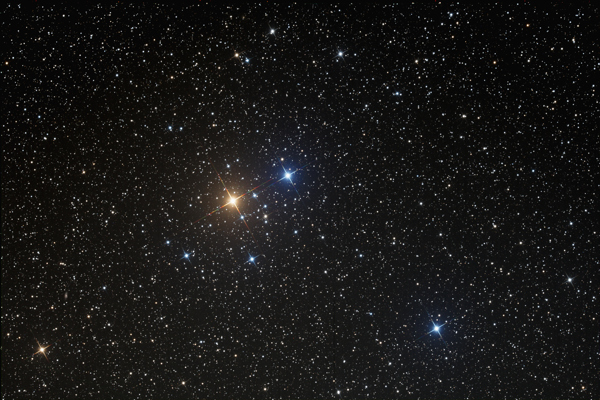Stephenson 1 and NGC 6765 in Lyra
July 2020 - Nebula and Cluster of the Month
In this new feature, I will be introducing an open cluster and/or a nebula (reflection, emission or planetary) each month.
In July, the bright little constellation of Lyra lies high in the sky and provides both our objects for this month.
Firstly, the cluster. This month I’m going to introduce an often-overlooked, though bright, open cluster. It was missed (or ignored) by the Herschels, and never found its way into the NGC. It’s known as Stephenson 1, or more prosaically as C 1851+368. It lies around the 4.3 magnitude star δ2 Lyrae, the brighter of the double δ Lyrae.

Stephenson 1 has had a chequered career, initially being thought a cluster, then later an asterism and now again is believed by most authorities to be a true open cluster.
Archinal & Hynes’ ‘Star Clusters’ (A&H) states that it contains 77 stars and has a diameter of 40’, though the Deep-Sky Field Guide to Uranometria grants it only 15 stars within a 20’ diameter. The visual appearance is somewhere between these.
The Trumpler classification of this cluster is IV3p, which translates as ‘Not well detached’ (IV), ‘wide magnitude range, a mix of bright and faint stars’ (3), ‘poor – fewer than 50 stars’ (p). If A&H is correct, this should be amended to ‘m’ for ‘medium, 50 – 100 stars’. Visually, it looks better than this.
My observation, made with a 12” Newtonian reflector and a field size of 36’ (x81) is as follows:
Clustered around δ1 and δ2 Lyrae, this is a very bright but poor cluster. Several bright stars are spread across the 36' field with fainter ones scattered amongst them. Although very loose, it stands out well from the Milky Way background on low power, so pretty well detached. About 70 stars were counted in the 36' field.
Although not a spectacular cluster, this is a very pretty object, the lovely colour contrast between the M-type δ2 and the B-type δ1 being a highlight. It’s worth a moment of your time.
Now to the nebula. This month we’re going to look at a planetary nebula in Lyra. No, not that one. There are several planetary nebulae in Lyra, but the second-brightest one is NGC 6765.
It lies in the south-east of the constellation, a little over a degree from the globular cluster M56.
NGC 6765 was discovered by Albert Marth (1828 – 1897) in 1864. Marth deserves to be better known. He discovered over 600 ‘nebulae’ during his career (584 of which are in the NGC) and was also the discoverer of asteroid 29 Amphitrite.
At magnitude 12.9, this object should be fairly easy to spot. I have found it difficult without a filter, though. A UHC filter will show it, but the best views I have had (with 12” and 16” reflectors) were with an OIII filter. Once found, it looks quite peculiar. Lower powers show a fairly large disc (about 40” diameter), but on higher power, it reveals itself to be very elongated. There are two tiny twinkles involved in it, more or less at each end. These may be stars or condensations. More careful examination reveals a dark area splitting the object along its longest axis, though the nebulosity on the ‘far’ side of this gap is very faint.
| Object | RA | Dec | Type | Magnitude |
|---|---|---|---|---|
| Stephenson 1 | 18h 54m 31s | +36° 53’ 59” | Open cluster | 3.8 |
| NGC 6765 | 19h 11m 07s | +30° 32’ 45” | Planetary nebula | 12.9 |
Patrick Maloney